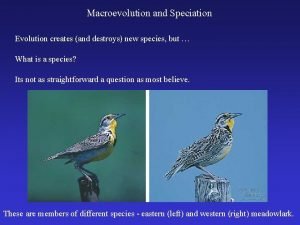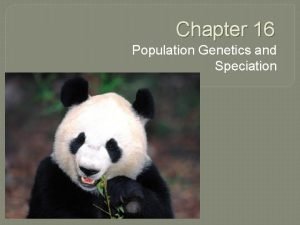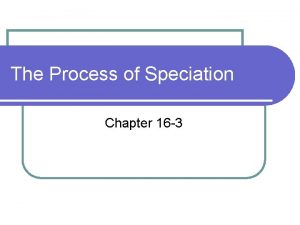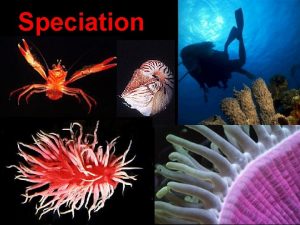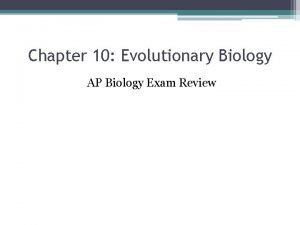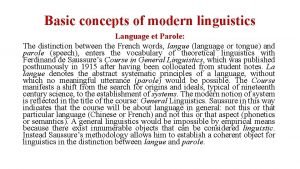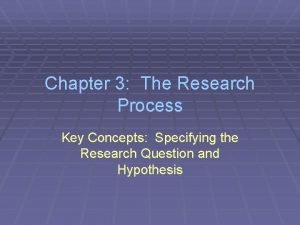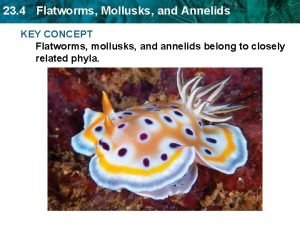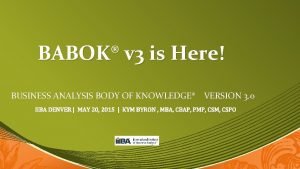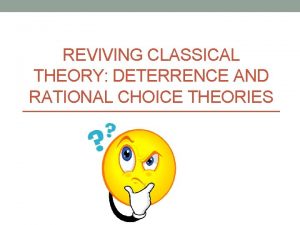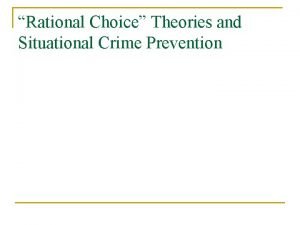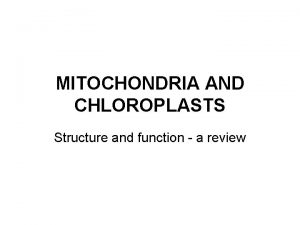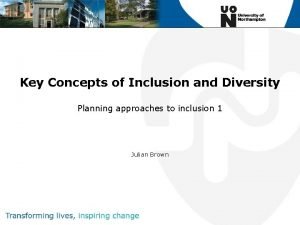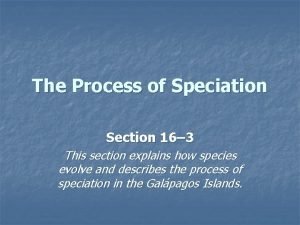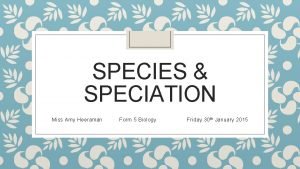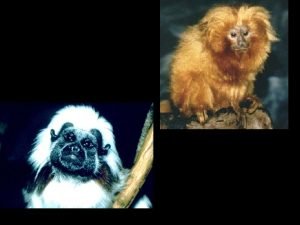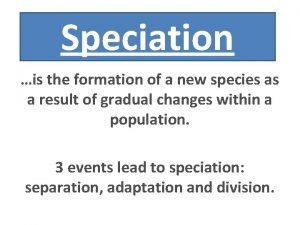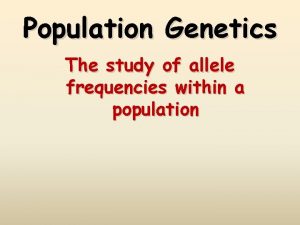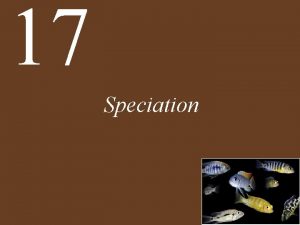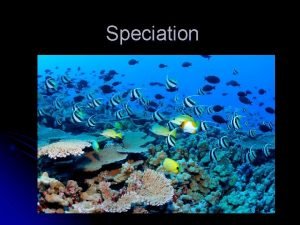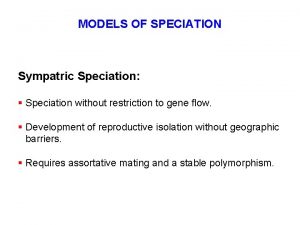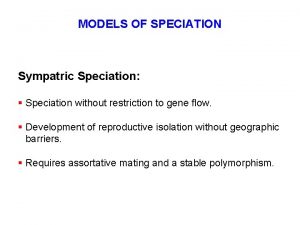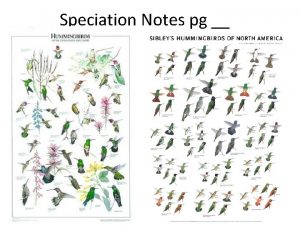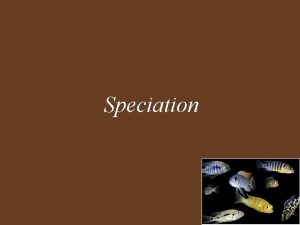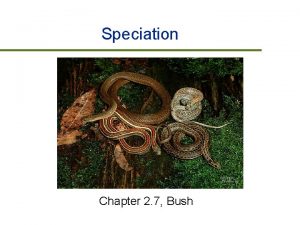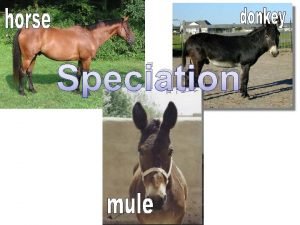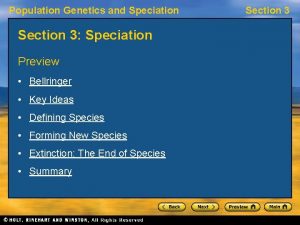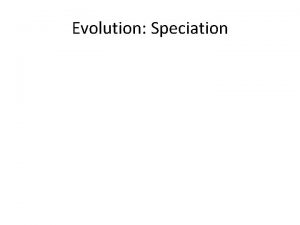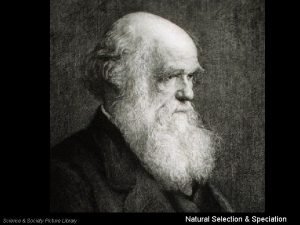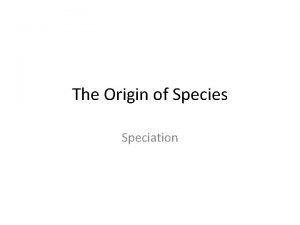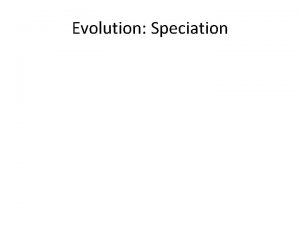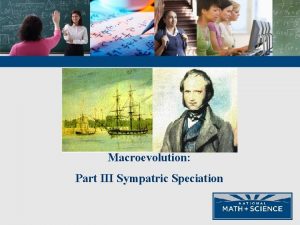17 Speciation Chapter 17 Speciation Key Concepts 17










































- Slides: 42

17 Speciation

Chapter 17 Speciation Key Concepts 17. 1 Species Are Reproductively Isolated Lineages on the Tree of Life 17. 2 Speciation Is a Natural Consequence of Population Subdivision 17. 3 Speciation May Occur through Geographic Isolation or in Sympatry 17. 4 Reproductive Isolation Is Reinforced When Diverging Species Come into Contact

Chapter 17 Opening Question Can biologists study the process of speciation in the laboratory?

Concept 17. 1 Species Are Reproductively Isolated Lineages on the Tree of Life Species: groups of organisms that mate with one another Speciation: divergence of biological lineages and emergence of reproductive isolation between lineages Most of the species concepts proposed by biologists are different ways of approaching the question “What are species? ”

Concept 17. 1 Species Are Reproductively Isolated Lineages on the Tree of Life Linnaeus described species based on their appearance—the morphological species concept. Members of species look alike because they share many alleles. He originated the binomial system of nomenclature.

Figure 17. 1 Members of the Same Species Look Alike—or Not

Concept 17. 1 Species Are Reproductively Isolated Lineages on the Tree of Life Limitations: • Members of the same species do not always look alike (e. g. , male and female hooded mergansers) • Cryptic species—two or more species that are morphologically indistinguishable but do not interbreed

Figure 17. 2 Cryptic Species Look Alike but Do Not Interbreed

Concept 17. 1 Species Are Reproductively Isolated Lineages on the Tree of Life Ernst Mayr’s Biological species concept • Species are groups of actually or potentially interbreeding natural populations that are reproductively isolated from other such groups. Reproductive isolation: two groups of organisms can no longer exchange genes

Concept 17. 1 Species Are Reproductively Isolated Lineages on the Tree of Life Lineage species concept: species as branches on the tree of life A lineage is an ancestor–descendant series of populations followed over time. Each species has a history that starts with a speciation event—one lineage is split into two and ends either at extinction or at another speciation event.

Concept 17. 1 Species Are Reproductively Isolated Lineages on the Tree of Life The various species concepts emphasize different aspects of species or speciation. Reproductive isolation allows sexual species to evolve independently and is necessary for lineages to remain distinct over evolutionary time. The lineage concept accommodates asexually reproducing species and extends over evolutionary time.

Concept 17. 2 Speciation Is a Natural Consequence of Population Subdivision Not all evolutionary changes result in new species. Speciation requires interruption of gene flow. How can one lineage ever split into two reproductively isolated species?

Concept 17. 2 Speciation Is a Natural Consequence of Population Subdivision The Dobzhansky–Muller model: • A population is subdivided and then the two groups evolve independently. • In each lineage, new alleles become fixed at different loci. The new alleles at the two loci are incompatible with one another. • Genetic incompatibility between the two isolated populations will develop over time.

Concept 17. 2 Speciation Is a Natural Consequence of Population Subdivision In bats of the genus Rhogeessa, chromosomal rearrangements in different lineages have led to speciation. Hybrids between some types will not be able to produce normal gametes because the chromosomes cannot pair normally in meiosis.

Figure 17. 4 Speciation by Centric Fusion

Concept 17. 2 Speciation Is a Natural Consequence of Population Subdivision As species diverge genetically, reproductive isolation increases. Development of reproductive isolation may take millions of years or may develop in a few generations (e. g. , the Rhogeessa bats).

Figure 17. 5 Reproductive Isolation Increases with Genetic Divergence

Concept 17. 3 Speciation May Occur through Geographic Isolation or in Sympatry Allopatric speciation—when populations are separated by a physical or geographic barrier Barriers can form when continents drift, sea levels rise and fall, glaciers advance and retreat, or climates change. The populations evolve through genetic drift and adaptation to different environments in the two areas.

Concept 17. 3 Speciation May Occur through Geographic Isolation or in Sympatry Pairs of sister species (species that are each other’s closest relatives) may exist on opposite sides of a geographic barrier. • Example: The Pleistocene glaciation isolated fish populations in the Ozark and Ouachita mountains from fish populations in the eastern highlands, resulting in sister species pairs.

Figure 17. 6 Allopatric Speciation (Part 1)

Figure 17. 6 Allopatric Speciation (Part 2)

Concept 17. 3 Speciation May Occur through Geographic Isolation or in Sympatry Some members of a population may cross an existing barrier and establish an isolated population. Finch species in the Galápagos Islands evolved from a single South American species that colonized the islands. The islands are far apart and have different environmental conditions.

Figure 17. 7 Allopatric Speciation among Darwin’s Finches (Part 1)

Figure 17. 7 Allopatric Speciation among Darwin’s Finches (Part 2)

Concept 17. 3 Speciation May Occur through Geographic Isolation or in Sympatry Sympatric speciation—speciation without physical isolation May occur with disruptive selection—individuals with certain genotypes prefer distinct microhabitats where mating takes place. This appears to be taking place with apple maggot flies. One group prefers to lay eggs on hawthorne fruits, the other group lays eggs on apples. They are partially reproductively isolated.

Concept 17. 3 Speciation May Occur through Geographic Isolation or in Sympatry Sympatric speciation most commonly occurs by polyploidy—duplication of sets of chromosomes within individuals. Autopolyploidy—chromosome duplication in a single species Allopolyploidy—combining chromosomes of two different species

Concept 17. 3 Speciation May Occur through Geographic Isolation or in Sympatry A tetraploid can result if two accidentally unreduced diploid gametes combine. Tetraploid and diploid individuals are reproductively isolated because their hybrid offspring are triploid. But tetraploids can self-fertilize or mate with another tetraploid. Thus polyploidy can result in complete reproductive isolation in two generations.

Concept 17. 3 Speciation May Occur through Geographic Isolation or in Sympatry Hybridization between closely related species can disrupt normal meiosis and result in chromosomal doubling. Allopolyploids are often fertile: each chromosome has a partner to pair with in meiosis.

Concept 17. 3 Speciation May Occur through Geographic Isolation or in Sympatry Speciation by polyploidy is common in plants— about 70% of flowering plant species and 95% of fern species. It is more common in plants because many can self-fertilize. It has also occurred in animals (e. g. , the gray tree frogs).

Concept 17. 4 Reproductive Isolation Is Reinforced When Diverging Species Come into Contact Over many generations, differences accumulate in isolated lineages, reducing the probability that individuals could mate successfully when they come back into contact. If reproductive isolation is incomplete, hybridization can occur. Hybrids may be less fit, and selection favors non-hybridizing parents. Selection results in reinforcement of isolating mechanisms.

Concept 17. 4 Reproductive Isolation Is Reinforced When Diverging Species Come into Contact Prezygotic isolating mechanisms prevent hybridization from occurring. Postzygotic isolating mechanisms reduce fitness of hybrid offspring. Postzygotic mechanisms result in selection against hybridization, which leads to reinforcement of prezygotic mechanisms.

Concept 17. 4 Reproductive Isolation Is Reinforced When Diverging Species Come into Contact Prezygotic isolating mechanisms: • Mechanical isolation—differences in sizes and shapes of reproductive organs § In plants, it may involve pollinators.

Figure 17. 8 Mechanical Isolation through Mimicry

Concept 17. 4 Reproductive Isolation Is Reinforced When Diverging Species Come into Contact • Temporal isolation—species may breed at different times of year or different times of day § Example: closely related leopard frog species that breed at different times of the year

Concept 17. 4 Reproductive Isolation Is Reinforced When Diverging Species Come into Contact • Behavioral isolation—individuals reject or fail to recognize mating behaviors of other species § Examples: mating calls of male frogs and coloration of male cichlid fish species

Figure 17. 10 Behavioral Isolation in Mating Calls

Concept 17. 4 Reproductive Isolation Is Reinforced When Diverging Species Come into Contact Whether plant species hybridize may depend on their pollinators. Flower color and shape influence which pollinators are attracted or alters where pollen is deposited. Two sympatric species of columbines (Aquilegia) have diverged in flower color, structure, and orientation. One is pollinated by hummingbirds, the other by hawkmoths.

Figure 17. 11 Floral Morphology Is Associated with Pollinator Morphology

Concept 17. 4 Reproductive Isolation Is Reinforced When Diverging Species Come into Contact • Habitat isolation—when two closely related species evolve preferences for living or mating in different habitats § Example: apple maggot flies and Lake Malawi cichlids) • Gametic isolation—sperm and eggs of different species will not fuse—important for aquatic animals that release gametes into the water

Concept 17. 4 Reproductive Isolation Is Reinforced When Diverging Species Come into Contact Postzygotic isolating mechanisms Genetic differences in diverging lineages may reduce fitness of hybrid offspring: • Low hybrid zygote viability • Low hybrid adult viability • Hybrid infertility

Answer to Opening Question Some aspects of speciation can be studied in the laboratory, using organisms with short generation times. Experiments using fruit flies showed that divergence in habitat preference resulted in reproductive isolation in 35 generations. Similar habitat selection is thought to have had a role in early speciation of cichlids in Lake Malawi.

Figure 17. 14 Evolution in the Laboratory
 Isolating mechanism
Isolating mechanism Population genetics and speciation worksheet answer key
Population genetics and speciation worksheet answer key Section 16-3 the process of speciation
Section 16-3 the process of speciation Speciation scenarios reinforcement answer key
Speciation scenarios reinforcement answer key Chapter 17 promotional concepts and strategies answer key
Chapter 17 promotional concepts and strategies answer key Apa itu key partners
Apa itu key partners Key partners
Key partners Russian formalism شرح
Russian formalism شرح Key concepts examples
Key concepts examples Period 6 key concepts apush
Period 6 key concepts apush Apush period 5 key concepts
Apush period 5 key concepts Period 3 apush key concepts
Period 3 apush key concepts Apush key concepts period 2
Apush key concepts period 2 Key concepts of qualitative research
Key concepts of qualitative research Feminist therapy
Feminist therapy Reviewing key concepts reproductive barriers
Reviewing key concepts reproductive barriers Language vs parole
Language vs parole Apush unit 2 key concepts
Apush unit 2 key concepts Apush college board key concepts
Apush college board key concepts Key concepts of history
Key concepts of history Apush key concepts period 2
Apush key concepts period 2 Apush key concepts period 1
Apush key concepts period 1 Key concepts in research
Key concepts in research Key concepts of management
Key concepts of management Apush period 9 key concepts
Apush period 9 key concepts Unit 1: basic economic concepts answer key
Unit 1: basic economic concepts answer key Signifier and signified
Signifier and signified Key learning point
Key learning point Spitting in clients soup
Spitting in clients soup Reviewing key concepts: flatworms, annelids, and roundworms
Reviewing key concepts: flatworms, annelids, and roundworms Business analysis key concepts
Business analysis key concepts Reformative theory
Reformative theory Rational choice theory key concepts
Rational choice theory key concepts Chloroplast structure and function
Chloroplast structure and function Key concepts in cultural studies
Key concepts in cultural studies Operations management course outline
Operations management course outline Key concepts of diversity
Key concepts of diversity Modes of speciation ppt
Modes of speciation ppt Example of biological species
Example of biological species Horizontal gene transfer
Horizontal gene transfer Speciation or the formation of new species is
Speciation or the formation of new species is Allopatric speciation example
Allopatric speciation example Genetics
Genetics
